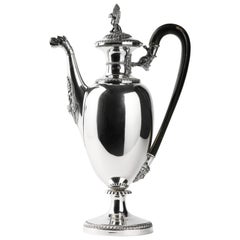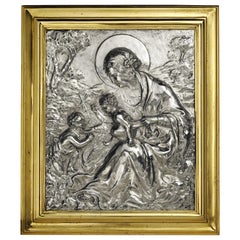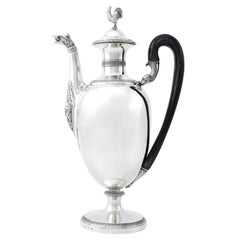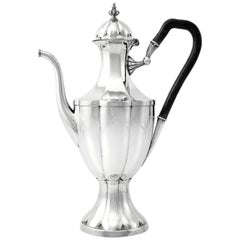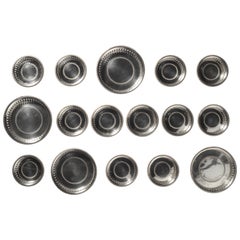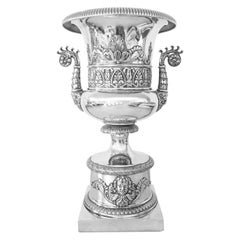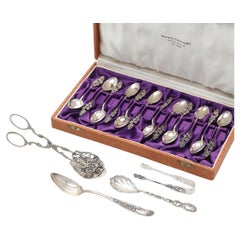SUBERT Sterling Silver
to
5
1
4
5
5
5
5
1
5
5
5
1
5
5
5
Ancient Italian Neoclassic Sterling Silver Coffee Pot, Milan, circa 1850
Located in Milano, IT
Embossed and engraved sterling silver coffee pot
Tommaso Panizza (1805-1868)
Milan, circa half of the 19th century
It measures 13.97 in (cm 35.5) in height x 8.66 in (22 cm) x 4.7...
Category
Antique 1840s Italian Neoclassical Sterling Silver
Materials
Sterling Silver
19th Century Italian Sterling Silver Madonna, circa 1830
Located in Milano, IT
Embossed and engraved silver plaque
La Madonna del lago (The Madonna of the Lake)
Probably Milan, post 1824
Brass frame
It measures 16.14 in x 13.85 in (41 x 35.2 cm) and it weighs 10.357 pounds (4.698 g): silver 1.31 pounds (598 g) + brass 9.03 pounds (4.100 g)
State of conservation: some abrasions on the bottom. The frame is old, but not original.
The plaque is made up of a sheet of embossed and engraved silver, and held in a solid brass frame. It depicts the “Madonna del lago” – “Madonna of the Lake” - (the Madonna with Child and San Giovannino) by Marco d'Oggiono (Oggiono, 1474 circa - Milan, 1524 circa), while changing only the background landscape. Almost certainly the subject reproduced in the plaque was taken from a famous engraving by Giuseppe Longhi (Monza, 1766 - Milan, 1831), one of the greatest engravers of his era.
The silver is unmarked, probably because originally the Madonna was due to be exposed in a church: sometimes precious metals destined for worship and liturgical use would be exempted from payment and were, therefore, not marked.
It is very likely that the plaque was made in Milan because in this city in 1824 the engraving by Giuseppe Longhi was made and printed. In addition, in Milan, the alleged lost painting by Leonardo da Vinci in his Milanese period (1482-1500) would be produced; this is the painting from which Marco d'Oggiono took his version.
The painting
Marco d?Oggiono was one of Leonardo da Vinci's most brilliant students and collaborators (D. Sedini, Marco d’Oggiono, tradizione e rinnovamento in Lombardia tra Quattrocento e Cinquecento, Roma 1989, pp. 151-153, n. 56; p. 225, n. 124, with previous bibliography). His style reflects in every way that of the Tuscan Maestro, so much so that he was the one who executed some copies of da Vinci's paintings. The execution of the “Madonna del Lago” probably draws inspiration from a lost painting by the Maestro, created while he was living in Milan (1482-1500). There are many similarities with other works by Leonardo such as the “Vergine delle rocce” or the “Vergine con il Bambino e San Giovannino, Sant’Anna e l’Agnello”.
The painting, from which the drawing and then the famous engraving were taken, is found today at the M&G Museum of Bob Jones University in Greenville, South Carolina, where it came to rest after the sale of the Harrington Collection in London in 1917.
The work appears in the inventories of the collection of Napoleon and Joséphine Bonaparte at the castle of Malmaison, before 1809.
The Malmaison building was born and developed in the 17th and 18th centuries. In the 18th century it belonged to Jacques-Jean Le Coulteux du Molay, a wealthy banker. Later, during the Directory, Joséphine Bonaparte de Beauharnais bought it on April 21st, 1799, but settled at the castle definitively only after her husband separated from her in 1809. She remained there until 1814, the year of her death. When Joséphine died, the estate passed to her son Eugène de Beauharnais, who moved to Munich with his whole family in 1815, bringing with him the collection of paintings he inherited from his mother. Eugène died in 1824 and his wife Augusta of Bavaria (von Bayern), unable to keep it, in 1828 sold the Malmaison to the Swedish banker Jonas-Philip Hagerman.
It is likely that in this period Augusta also sold part of the paintings inherited from her husband, including the “Madonna del Lago”. This painting then came into the possession of Leicester Stanhope, fifth Earl of Harrington (1784 - 1862) and then was passed down to his descendants.
In 1917, at the death of Charles, eighth Earl of Harrington, his brother Dudley inherited the title and properties and he put up a part of his collections for sale. Among these, precisely, the painting by Marco d'Oggiono was to be found.
On the occasion of that auction the painting was presented as a work by Cesare da Sesto, by virtue of a handwritten note by the Countess of Harrington on the back of the table. However, already in 1857, the German critic Gustav Waagen had identified Marco d'Oggiono as the author of the painting, then exhibited in the dining room of Harrington House in London (Treasures of Art in Great Britain, in 4 volumes, London, 1854 and 1857).
The engraving
Giuseppe Longhi was one of the most renowned engravers in Italy between the end of the 18th century and the first quarter of the 19th century.
In 1824 Giuseppe Longhi, based on a design by Paolo Caronni, made a famous engraving of the painting of Marco d?Oggiono. The activity of Longhi was then at the peak of his notoriety, enough to earn him very substantial commissions; it is not risky to suppose that some of his successful engravings were also reproduced using other means: in our case in silver. (A. Crespi, a cura di, Giuseppe Longhi 1766–1831 e Raffaello Morghen...
Category
Antique 1820s Italian Neoclassical Sterling Silver
Materials
Sterling Silver, Brass
Large Italian Neoclassic Sterling Silver Coffee Pot, Milan, Circa 1830
Located in Milano, IT
Embossed and engraved silver coffee pot
Antonio Garavaglia
Milan, Circa 1830
It measures 16.92 in (43 cm) in height and weighs 3.35 lb (1.520 gr)
State of conservation: very good
The large silver coffee pot has a round mouthpiece with a marked everted rim on which a pagoda lid rests; this is surmounted by a cock-shaped knob with a border decorated with small pods...
Category
Antique 1820s Italian Neoclassical Sterling Silver
Materials
Sterling Silver
Ancient Neoclassic Sterling Silver Coffee Pot, Palermo, Sicily circa 1789
Located in Milano, IT
Ancient Neoclassic Sterling Silver Coffee Pot, Palermo, Sicily circa 1789
Embossed and engraved silver coffee pot
Silversmith, probably Agostino Natoli
Diego Di Maggio, Silversmith Consul in 1789 and 1796
Palermo, 1789
It measures 14.17 in (36 cm) high and weighs 2.76 lb (1.252 g)
State of conservation: few signs of use and some slight blemishes
The large silver coffee pot has a round mouthpiece with a markedly everted rim, on which hinges a domed lid with very full molded pod shapes; a closed bud surmounted by a small sphere serves as a knob. The polygonal neck descends and widens into molded elements that come together, with larger pods, at the point where it is attached to the body. The body in turn is united to a well-shaped foot, which ends in a flat base with a vertical rim.
From the body rises a spout with a circular mouth accented with a thick rim. An angled loop, made of ebonized wood, is applied to the neck by means of a double-cone element having a sphere at its center; it ends in a silver cone...
Category
Antique 1780s Sicilian Neoclassical Sterling Silver
Materials
Sterling Silver
19th Century Italian Sterling Silver Glass and Wine Coasters, circa 1830
By Antonio Mantelli
Located in Milano, IT
Twelve silver glass coasters and four silver wine coasters.
Silversmith Antonio Mantelli
Milan, circa 1830
They measure:
Glass coasters: 0.78 in high x 3.46 in diameter (2 cm x 8.8 c...
Category
Antique 1820s Italian Neoclassical Sterling Silver
Materials
Sterling Silver
Related Items
Early 19th Century Italian Neoclassical Silver Urn Vase Milan by Emanuele Caber
Located in Worpswede / Bremen, DE
A very decorative neoclassical silver urn stamped by the Italian silversmith Emanuele Caber, dating from around 1825. It has the Milan warranty stamp, and stamp of the silver finenes...
Category
Antique Early 19th Century Italian Neoclassical Sterling Silver
Materials
Silver
$2,828
H 10.24 in W 4.14 in D 4.14 in
Exclusive Tea COFFEE SPOONS, 12pcs. Sterling Silver & Box Cake Spatula & TONGS.
Located in Wembley, GB
A Rare case set of 12 gilded inside antique valuable floral handle sterling silver Spoons. An elegant Vintage Sterling Silver Tea / Coffee Spoon Set. A cased set of 1915 12 x silver ...
Category
Vintage 1910s Swedish Art Deco Sterling Silver
Materials
Gold Plate, Silver, Sterling Silver
$1,950 Sale Price
20% Off
H 0.08 in W 0.99 in D 5.12 in
Sterling Silver Rooster Sculpture
Located in Los Angeles, CA
This sterling silver heavy hollow body rooster figure is signed 925 on the base and is in fine condition.
Beautifully made and proportioned well. Great patina.
Category
20th Century American Folk Art Sterling Silver
Materials
Sterling Silver
Large Pair of Neoclassical Sterling Silver Column-Form Candlesticks
By Henry Wigfull
Located in New York, NY
Large pair of Neoclassical (made in the Victorian Period), sterling silver column-form candlesticks, Sheffield, England, year-hallmarked for 1898, Henry Wigful - maker. Each candlestick measures 11 1/6 inches high x 5 1/4 inches deep x 5 1/4 inches wide. Columns are swirled in design. The capital of each column is designed with acanthus leaves. The base of each candlestick is decorated with profiles of the Green Man (a good luck symbol...
Category
Antique 1890s English Neoclassical Sterling Silver
Materials
Sterling Silver
$4,500 / set
H 11.07 in W 5.25 in D 5.25 in
21st Century Italian Sterling Silver Miniature of Saddle, Boots, Hat and Whip
By La Medusa Oro
Located in VALENZA, IT
Miniature in 925 sterling silver depicting a saddle, boots, hat and whip for a jockey resting on a wooden fence.
The workmanship is in fusion and finished with chisel.
The object c...
Category
2010s Italian Other Sterling Silver
Materials
Sterling Silver
$297 Sale Price / item
20% Off
H 3.15 in W 3.94 in D 2.37 in
Pair of Early 19th Century Old Sheffield Plate Wine Coasters, U.K. Circa 1830
Located in Ottawa, Ontario
A very handsome pair of re-plated 'Old Sheffield Plate' wine or decanter slides / coasters, both showing rims decorated with shell & scroll cast motifs, rising from turned wood bases...
Category
Antique Mid-19th Century British Georgian Sheffield and Silverplate
Materials
Silver Plate
$675 / set
H 1.75 in Dm 7.25 in
20th Century Italian Sterling Silver Pair Candelabras Neoclassical Style
By Mario Poli
Located in VALENZA, IT
Pair of 5-light candelabra in 925 sterling silver in neoclassical style.
Candelabra formed by an iron eye stem and a Hellenic part in Ionic style in 925 silver.
The iron eye is a sto...
Category
1990s Italian Neoclassical Candelabras
Materials
Sterling Silver
$17,090
H 15.36 in Dm 11.03 in
Pair of Italian Empire Silver Candlesticks, Milan, circa 1810
Located in Vienna, AT
Pair of elegant Empire candleholders on an unfilled base, conical structure, offset olive-shaped grommets with a flat, plate-shaped drip edge, smoo...
Category
Antique 1810s Italian Empire Sterling Silver
Materials
Silver
Pair of 19th Century Sterling Silver Candlesticks
Located in Hamilton, Ontario
Pair of 19th century weighted sterling silver candle holders.
Category
Antique 19th Century Sterling Silver
Materials
Sterling Silver
Silver 925 Cutlery Set for 12 People Signed Bruckmann Germany Late 19th Century
By Bruckmann & Söhne
Located in Buenos Aires, Buenos Aires
Silver 925 Cutlery set for 12 people signed Bruckmann. Germany, late 19th century.
Complete for 12 people.
A total of 170 pieces:
12 large kni...
Category
Antique Late 19th Century German Neoclassical Sterling Silver
Materials
Silver
$25,000 / set
H 15.36 in W 20.08 in D 16.15 in
Sterling Silver Tiffany Coffee/Tea Pot
By Tiffany & Co.
Located in Brooklyn, NY
Being offered is a sterling silver coffee/tea pot made by the world renowned Tiffany and Company. It has a wood handle so it’s never an issue to hold — no matter how hot the pot is....
Category
Vintage 1940s American Sterling Silver
Materials
Sterling Silver
Antique German Silver Coffee Pot
Located in Jesmond, Newcastle Upon Tyne
A fine and impressive antique German silver coffee pot; an addition to our silver teaware collection
This impressive antique German silver coffee p...
Category
Antique 1850s Sterling Silver
Materials
Silver
